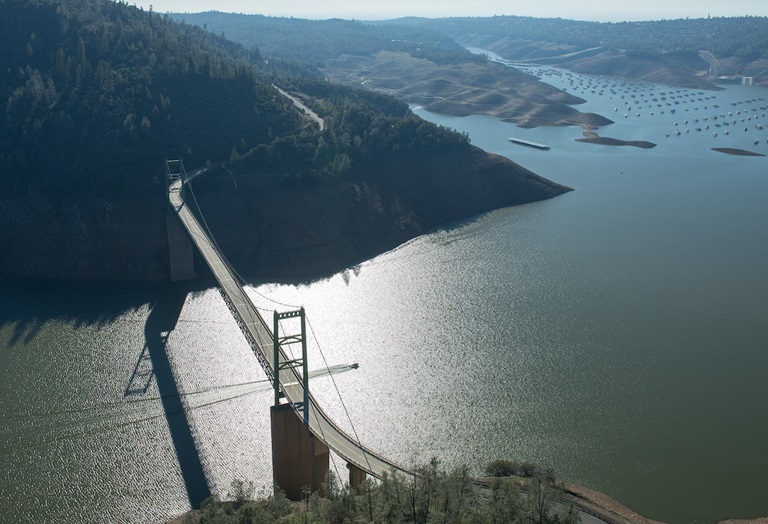Lake Oroville Community Update - December 20, 2019
Aerial view of Lake Oroville. DWR/2019
New Traffic Calming Devices Installed at Spillway Boat Ramp Access Road
Motorists returning to Lake Oroville’s Spillway Boat Ramp area will notice the temporary rubber traffic calming devices, or speed bumps, near the security kiosks have been replaced. The new, permanent speed bumps will maintain traffic safety while providing improved travel, particularly for visitors towing boats or trailers. Motorists are encouraged to be alert and abide by all speed limit restrictions.
Oroville Field Division Starts Controlled Burns in Lake Oroville Cove
Every spring, Oroville Field Division (OFD) maintenance crews collect floating debris carried into Lake Oroville by winter rains from the three forks of the Feather River. Logs, branches and other floating debris is secured and towed to a remote cove on the Feather River’s South Fork arm of the lake. As summer water deliveries result in lower lake levels, the floating debris is deposited on the shoreline. After the first rains of the season, OFD’s maintenance crews pile the logs into small piles for burning. The public is advised to use caution if visiting the area. These controlled burns will continue until all of the debris is removed.
DWR Installation of New Lighting on Main Spillway to Occur in 2020
Following manufacturer’s instructions, new lighting installed on Oroville Dam’s main spillway will remain on for a continuous 72-hour period as part of activation testing. It’s anticipated this testing period will take place after the beginning of the new year. The public’s patience is appreciated as DWR complies with the lights’ activation requirements. After testing is complete, the lights will then be used intermittently based on operational needs.
Hydroseeding at Spillway Reconstruction Area Prevents Erosion
Areas of hillside near Oroville Dam’s reconstructed main spillway will appear bright green due to the application of a hydroseed mix for site stabilization and erosion control. The hydroseed mix helps to reestablish a root structure in the soil profile to hold it in place. Native species such as yarrow, fescue, California poppy and lupine will help to restore natural ground cover and the green-colored bonded fiber matrix will hold the mix together until the seed can germinate. Hydroseeding is one component of the Oroville Spillways Emergency Recovery Project’s site rehabilitation activities that are scheduled over the next several years. Additional hydroseed will be applied as weather permits – approximately two weeks of dry weather is required for optimal applications. All areas will be monitored throughout the winter with re-applications occurring as needed.
California Experiences Many Types of Flooding – Are you Prepared?
After a dry summer and fall, wet winter storms add storage to the state’s reservoirs. Yet flooding caused by heavy rains can have devastating results and without proper preparedness, lives, homes, infrastructure and agriculture are at risk of being lost. This winter, be prepared with an emergency evacuation kit, pay attention to weather forecasts and listen to local authorities. Being aware of your risk, because being prepared and taking action can help keep you and your family safe. Visit DWR’s Flood Preparedness webpage for more flood safety tips.
Spillway Boat Ramp Area Holiday and Winter Access Hours
The winter access schedule for Lake Oroville’s Spillway Boat Ramp provides daily public access to the area from 6 a.m. to 8 p.m. Motorists are urged to turn on headlights and pay attention to pedestrian and bicyclist safety.
Walkers, joggers and bicyclists may continue to enjoy daily access on the pedestrian lane on the lakeside of Dam Crest/Oroville Dam Road from 5 a.m. to 11 p.m., as well as parking at the Upper Overlook. These access hours for Dam Crest/Oroville Dam Road will remain the same through the winter months.
Current Lake Operations
The elevation of Oroville reservoir is about 785 feet and storage is just over 2 million acre-feet. Daily average inflows to the lake have ranged between approximately 3,415 cfs (cubic feet per second) to 7,510 cfs over the past week.
A light amount of rain and snow is forecasted through the weekend and chances of additional rain and snow during the week of December 23 is also possible.
Water is being released from Lake Oroville at a rate of about 3,100 cfs. Water from the reservoir is being used locally for rice decomposition and to support waterfowl habitats and is also being used to meet Feather River flow and environmental requirements in the Sacramento-San Joaquin Delta. Current releases to the Feather River were decreased from 2,500 cfs to 2,300 cfs on December 20 due to decreased water requirements downstream and for conservation.
*all reservoir data as of midnight 12/19/19
